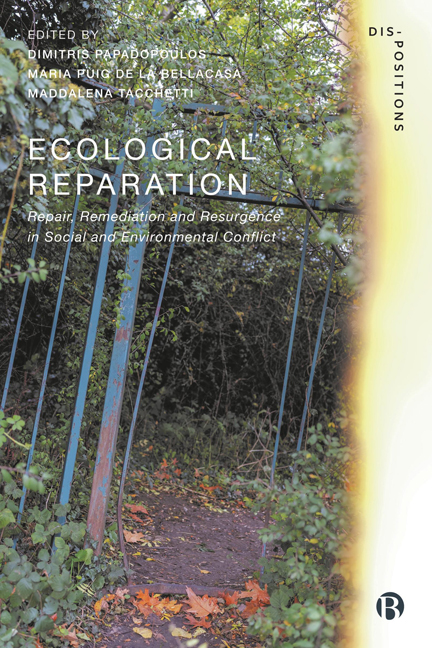Book contents
- Frontmatter
- Contents
- List of Figures
- Notes on Contributors
- Acknowledgements
- Note on the Figures
- Dis-Positions Series Preface
- Introduction: No Justice, No Ecological Peace: The Groundings of Ecological Reparation
- PART I Depletion<>Resurgence
- PART II Deskilling<>Experimenting
- PART III Contaminating<>Cohabiting
- PART IV Enclosing<>Reclaiming Land
- PART V Loss<>Recollecting
- PART VI Representing<>Self-governing
- PART VII Isolating<>Embodying
- PART VIII Growth<>Flourishing
- Index
23 - Technological Black Boxing versus Ecological Reparation: From Encased-Industrial to Open-Renewable Wind Energy
Published online by Cambridge University Press: 28 March 2024
- Frontmatter
- Contents
- List of Figures
- Notes on Contributors
- Acknowledgements
- Note on the Figures
- Dis-Positions Series Preface
- Introduction: No Justice, No Ecological Peace: The Groundings of Ecological Reparation
- PART I Depletion<>Resurgence
- PART II Deskilling<>Experimenting
- PART III Contaminating<>Cohabiting
- PART IV Enclosing<>Reclaiming Land
- PART V Loss<>Recollecting
- PART VI Representing<>Self-governing
- PART VII Isolating<>Embodying
- PART VIII Growth<>Flourishing
- Index
Summary
Retrieving the historical contrast between open and closed wind energy structures
Our present perception of wind energy technology is dominated by the version of wind turbines that we find in ‘wind farms’ (‘wind parks’), which is associated with landscape degradation and local resistance. Locals don’t want these turbines installed in their back yard, we don’t ever see them posing happily in front of them. Even their most ardent supporters, who promote them as an unavoidable necessity in the face of the global environmental crisis, agree that there is nothing aesthetically appealing about these wind turbines. They just charge the local opponents of these wind turbines with suffering from the ‘not in my back yard’ syndrome. The reference to such a syndrome is by itself an acknowledgement of the negative aesthetic impact of these wind turbines. The ‘energy landscapes’ produced by the installation of wind farm turbines are certainly not attractive. In fact, if the criterion for the evaluation of the merits of wind energy turbines is their impact on the landscape, wind farm turbines score no better than fossil fuel energy generation plants (Pasqualetti and Stremke, 2018).
There were, however, in the past versions of wind energy technology that people were looking forward to be in a picture with. Going through the album of pictures that T. Lindsay Baker collected in American Windmills: An Album of Historic Photographs leaves no doubt about it (Baker, 2012). The owners of the kind of wind energy technology that we find in this album, together with a crowd formed by their relatives and friends, posed happily in front of it on all important occasions: from a baptism ceremony that was taking place at a water tank filled through the use of a wind pump to a wedding ceremony that was bringing together a comparable crowd, which also posed in front of the wind pump and the farm house that it was right next to (or just behind of). As we see in the picture that Baker chose for the cover of his book, people could not simply pose in front of this wind energy technology; they could actually pose in it (and on it). We will here refer to this past farm wind energy technology as ‘open’, while we will argue that the wind farm energy technology of present day is ‘closed’.
- Type
- Chapter
- Information
- Ecological ReparationRepair, Remediation and Resurgence in Social and Environmental Conflict, pp. 362 - 376Publisher: Bristol University PressPrint publication year: 2023



